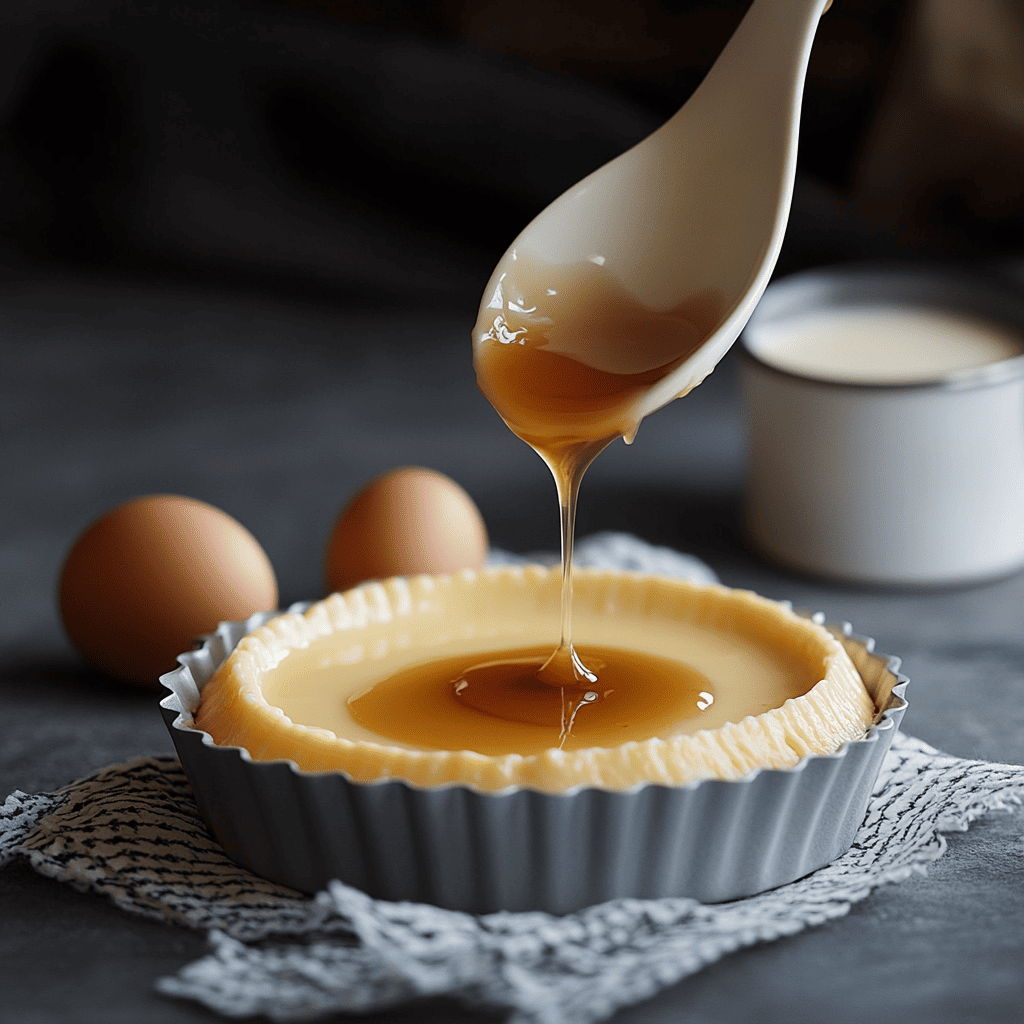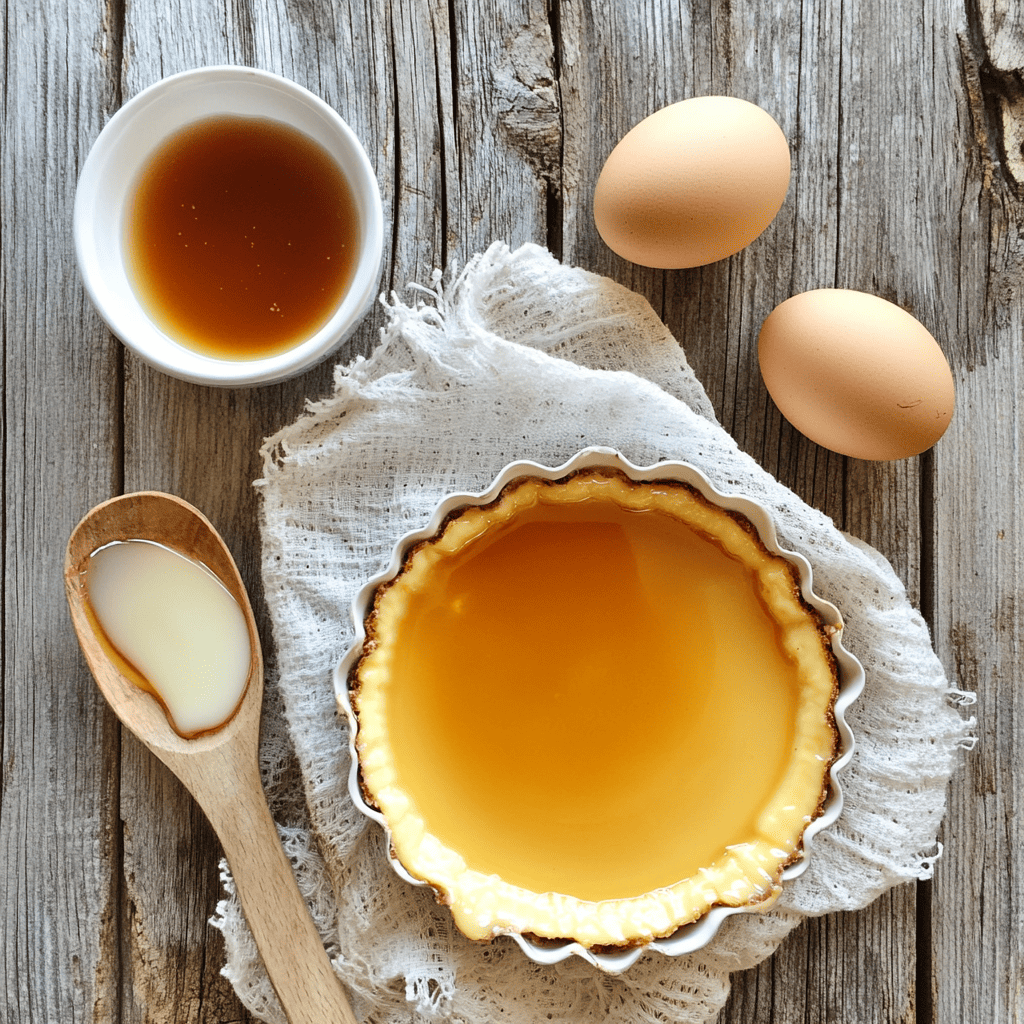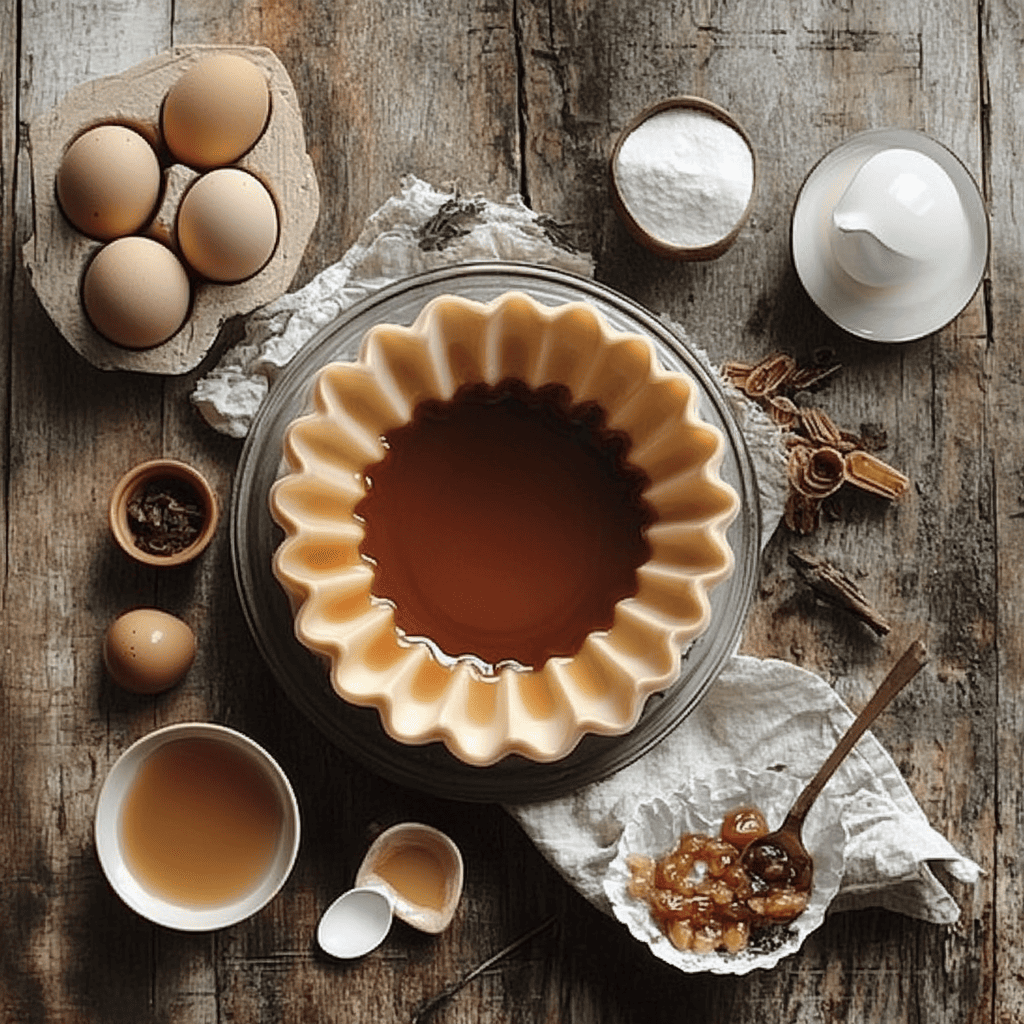Vanilla Flan in a Ring Mold with Caramel
Vanilla flan in a ring mold with caramel is a classic and elegant dessert that combines the smoothness of a creamy flan with the sweet and slightly bitter contrast of liquid caramel. This dessert, of European origin but deeply rooted in Latin American culture, is a perfect choice for special occasions, family celebrations, or simply to enjoy a sweet treat. Below, we present a detailed analysis of its preparation, history, and tips for achieving a flawless result.
Introduction
Vanilla flan is one of the most popular and beloved desserts around the world. Its smooth, silky texture, combined with the liquid caramel coating, makes it an irresistible dessert. The ring mold version adds a touch of elegance and sophistication, perfect for impressing your guests. It’s also relatively simple to prepare, although it requires attention to detail to achieve the perfect texture and flavor.
Vanilla flan in a ring mold with caramel is a classic dessert in international confectionery, distinguished by its smooth texture, delicate flavor, and irresistible caramel layer. It’s simple to prepare and requires few ingredients, making it an ideal choice for any occasion, from family gatherings to special celebrations.
This flan is made from a base of eggs, milk, and sugar, flavored with vanilla to enhance its flavor. Cooking in a bain-marie results in a creamy, firm texture, while the caramel adds a perfect contrast of sweetness and a shiny, elegant finish. Using a ring mold not only makes it more attractive, but also makes it easier to remove from the mold, allowing the caramel to cover the entire surface of the dessert evenly.
Vanilla flan is a recipe that has endured over time and has been adapted across different cultures, with variations that include ingredients like condensed milk, cream, or even spices to give it a special touch. However, its classic version remains one of the most beloved for its balance of flavors and silky texture.
This dessert is not only delicious but also versatile, as it can be served alone or with fresh fruit, whipped cream, or even a splash of liqueur to enhance its flavor. It’s also a great option to prepare in advance, as the refrigeration time allows the flavors to intensify and the texture to set perfectly.
Ultimately, vanilla flan in a ring mold with caramel is an elegant dessert, easy to make, and always well-received. Its combination of simple ingredients and a precise cooking technique results in a creamy, smooth delight that delights both young and old. A timeless classic that never goes out of style!
History of Flan
Flan has its roots in ancient Rome, where a similar version was prepared with eggs, milk, and honey. Over time, this recipe spread throughout Europe and arrived in the Americas during the colonial era, where it was adapted to local ingredients and tastes. In Latin America, flan became an iconic dessert, especially in countries like Mexico, Spain, and Argentina, where it is prepared in various versions, such as vanilla flan, cheese flan, and coffee flan.
Using a ring mold to present flan is a more modern technique that adds a touch of elegance and professionalism. This method allows the flan to have a uniform shape and a flawless finish, ideal for special occasions.
Vanilla flan with caramel is a dessert with a fascinating history dating back to ancient times. Its origins date back to the Roman Empire, when a mixture of eggs, milk, and honey began to be used to create sweet preparations. This combination gave rise to a type of baked custard that, over time, evolved into the flan we know today.
Origins in Ancient Rome
The Romans were the first to discover the ability of eggs to set when cooked, allowing them to create various recipes based on this ingredient. Originally, flan was sweetened with honey and sometimes served with pepper, as sugar was not yet available in Europe. With the expansion of the Roman Empire, this recipe spread to different regions, including the Iberian Peninsula, where it was refined with local ingredients.
Arab Influence and Expansion in Europe
During the Middle Ages, with the arrival of Arab culture to the Iberian Peninsula, the use of sugar and spices such as vanilla and cinnamon became more common in pastries. It was during this period that flan acquired its characteristic sweetness and more refined texture. Furthermore, the Arabs introduced the caramel technique, which later became an essential element of flan.
With the colonization of the Americas, flan spread to the New World, where it quickly became popular thanks to its simplicity and the ease with which its basic ingredients were found. In countries like Mexico, Argentina, and Venezuela, flan acquired its own variations, incorporating condensed milk and other flavors like coffee or coconut.
Vanilla Flan and Its Popularity in Modern Baking
Throughout the centuries, flan has remained one of the most beloved desserts in world cuisine. Its preparation has evolved, but the traditional vanilla flan with caramel recipe remains one of the most popular due to its smooth flavor and perfect balance of sweetness and creaminess.
The use of a ring mold has allowed for a more elegant presentation and easier removal, ensuring that the caramel evenly covers the surface of the flan. This small technical detail has made flan not only a delicious dessert, but also a visually appealing one for all types of events and celebrations.
Today, vanilla flan with caramel remains a classic dessert in many homes and restaurants, whether in its most traditional version or with innovations that incorporate different flavors and textures. Its legacy is proof of how a dessert with ancient roots can continue to win over palates throughout the centuries. A delicacy that never goes out of style!

Detailed Preparation
Ingredients:
For the caramel:
- 150 g of sugar
- 2 tablespoons of water
For the flan:
- 4 large eggs
- 1 can of condensed milk (395 g)
- 1 can of evaporated milk (370 ml)
- 1/2 cup of sugar
- 1 teaspoon of vanilla essence
- 1/2 cup whole milk
Procedure:
- Preparation of the caramel:
- In a pan over medium heat, place the sugar with the two tablespoons of water.
- Cook without stirring until the sugar is completely dissolved and begins to turn golden. It’s important not to stir to prevent crystallization.
- Immediately pour the caramel into the ring mold, making sure to cover the entire base evenly. Be careful, as the caramel is very hot.
- Preparation of the flan:
- In a large bowl, beat the eggs together with the sugar until well dissolved.
- Add the condensed milk, evaporated milk, whole milk, and vanilla extract. Beat until everything is well combined and the mixture is smooth and even.
- Strain the mixture to remove any lumps and ensure a smooth texture.
- Cooking:
- Preheat the oven to 180°C.
- Place the mold with the caramel on a large tray and pour hot water into the tray until it reaches halfway up the mold (bain-marie).
- Cook for approximately 45-60 minutes, or until a knife inserted into the center of the flan comes out clean.
- Cooling and demolding:
- Let the flan cool at room temperature for about 30 minutes.
- Refrigerate for at least 2 hours to firm up.
- To unmold, run a knife around the edges of the flan and carefully invert it onto a plate. The caramel will spill over the flan, creating a delicious, shiny finish.
- Serve:
- Serve the flan chilled, enjoying the smooth caramel on top and the creamy flan inside. You can garnish with fresh fruit, whipped cream, or a sprinkle of mint.

1-Frequently Asked Questions
- Can I use another type of mold?
- Yes, you can use a traditional flan mold, but the ring mold gives a more elegant and professional presentation.
- What happens if the caramel crystallizes?
- If the caramel crystallizes, it’s because it was stirred too much during cooking. To prevent this, don’t stir the sugar while it’s melting.
- Can I make flan without a bain-marie?
- It is not recommended, as a bain-marie ensures even cooking and prevents the flan from burning or drying out.
- How do I know if the flan is ready?
- Insert a knife into the center of the flan. If it comes out clean, it’s ready. If there’s any leftover batter, let it bake for a few more minutes.
- Can I freeze flan?
- Yes, you can freeze it, but it’s best eaten fresh to enjoy its creamy texture.
2-Questions about the Vanilla Flan in a Caramel Ring Mold- What is the origin of flan?
- Flan has its origins in Ancient Rome, where it was prepared with eggs, milk, and honey. Over time, the recipe was refined in the Middle Ages with Arab influence and the addition of caramel and sugar.
- A bain-marie allows for even and gentle cooking, preventing the flan from burning or becoming too hard. This technique helps achieve the dessert’s characteristic creamy texture.
- The caramel adds sweetness and a slightly bitter taste that balances the dessert. Plus, when you unmold the flan, it becomes a delicious, shiny coating.
- Yes, you can make a no-bake flan using gelatin or cornstarch to thicken the mixture on the stovetop. However, the texture will be different from that of baked flan.
- Some popular versions include coffee flan, chocolate flan, coconut flan, cheese flan, and Neapolitan flan, which is made with condensed milk.
- It is recommended to refrigerate it for at least 4 hours, although it is best to let it rest overnight so that it takes on better consistency and flavor.
- To avoid bubbles, it’s important not to over-beat the mixture and strain it before pouring it into the mold. The temperature of the double boiler must also be controlled to ensure slow and even cooking.
- Use fresh, good quality eggs for a better texture.Do not let the caramel burn, as this can give it a bitter taste.Let the flan set well before removing it from the mold to prevent it from breaking.
- Homemade flan tends to have a more authentic flavor and a creamier texture, while commercial flan sometimes contains preservatives and thickeners that alter its consistency.
- Whipped cream.Fresh fruits such as strawberries, blackberries or mango.Chocolate sauce or dulce de leche for an extra touch of flavor.
- What is the origin of flan?
- Yes, you can freeze it, but it’s best eaten fresh to enjoy its creamy texture.
Tips for Success
- Perfect Caramel: Don’t let the caramel burn, as it can turn bitter. Remove from heat when it turns light golden.
- Hot Bain-Marie: Make sure the water is hot when you place it on the baking sheet.
- Refrigeration: Flan tastes best cold, so let it rest in the refrigerator before serving.
- Careful unmolding: Run a knife around the edges of the mold before turning it out to prevent the flan from breaking.
Estimated preparation time
- Caramel preparation: 10 minutes
- Flan mix: 10 minutes
- Baked in a bain-marie: 60 minutes
- Cooling and refrigeration: minimum 4 hours (ideally overnight)
- Approximate total: 5 hours 20 minutes (with cooling)
Texture and flavor
- Texture: Smooth, creamy and silky, with a firm but delicate consistency.
- Flavor: Sweet, with a touch of vanilla perfectly balanced by the slightly bitter caramel.
Consumer context
- Classic dessert for parties, family gatherings and special dinners .
- Perfect to be served cold , accompanied by fruit or simply alone.
- Very common in Latin American countries and Spain as the end of a home-cooked meal.
Visual appearance
- Inverted ring mold , showing a shiny layer of golden candy on top.
- Pale yellow color in the body of the flan, with a smooth surface and defined edges.
- When cut, its homogeneous texture without bubbles can be appreciated.
Curiosities
- Although it looks sophisticated, it is a very simple recipe, ideal for beginners in baking .
- The ring mold is not just aesthetic: it helps the flan cook evenly.
- Caramel also acts as a natural release agent once cooled.
Estimated nutritional value (1/10 serving)
- Calories: 280–320 kcal
- Fats: 8–10 g
- Carbohydrates: 45–50 g
- Protein: 6–7 g
- Sugars: 40+ g
Additional benefits and interesting facts
- It can be personalized with orange zest, cinnamon or coffee .
- Unlike many desserts, it does not contain flour, so it is naturally gluten-free .
- High source of calcium thanks to its dairy derivatives.

Conclusion
Vanilla flan in a ring mold with caramel is a classic dessert that combines elegance and flavor. Its smooth, silky texture, along with the contrasting liquid caramel, make it a perfect choice for any occasion. Whether for a special dinner, a family celebration, or just a sweet treat, this flan is a choice that never disappoints. Go ahead and make it and surprise everyone with this delicious and sophisticated dessert!

